
Layia platyglossa, commonly called coastal tidytips, is an annual wildflower of the family Asteraceae, native to western North America.
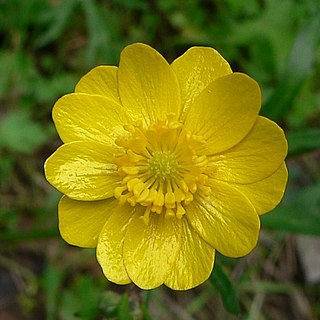
Ranunculus californicus, commonly known as the California buttercup, is a flowering plant of the buttercup family Ranunculaceae. It is a native of California, where it is common in many habitats, including chaparral and woodlands.

Stephanomeria is a genus of North American plants also known as wirelettuce, belonging to the tribe Cichorieae within the family Asteraceae.
Eriophyllum latilobum, the San Mateo woolly sunflower, is a perennial herb of sharply limited range, endemic and occurring only in the state of California, United States. This flowering plant of the family Asteraceae has been listed as an endangered species by the U.S. federal government as well as the state of California.

Cercocarpus traskiae, known by the common names Santa Catalina Island mountain-mahogany and Catalina mahogany, is a rare species of plant in the rose family.
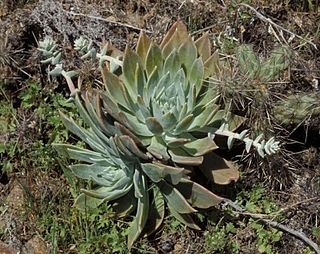
Dudleya traskiae is a rare succulent plant known by the common name Santa Barbara Island liveforever. This Dudleya is endemic to Santa Barbara Island, one of the Channel Islands of California, where it grows on rocky bluffs. The plant has a basal rosette of flat, spade-shaped fleshy leaves up to 15 centimeters long, which are pale green to yellowish. It erects tall stems bearing dense, rounded inflorescences of many bright yellow flowers.
Hazardia cana is a rare North American species of shrubs in the family Asteraceae known by the common names Guadalupe hazardia, San Clemente Island hazardia, or simply island hazardia. It is native to San Clemente Island, one of the Channel Islands of California, and to Guadalupe Island.
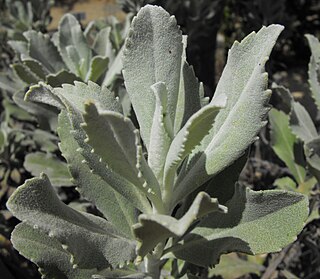
Hazardia detonsa is a rare species of shrub in the family Asteraceae known by the common name island bristleweed. It is endemic to the Channel Islands of California, having been found on 4 islands.

Acourtia microcephala is a species of flowering plant in the daisy family known by the common name sacapellote. It is native to southern California and Baja California, where it grows in woodland and chaparral, especially in the coastal mountain ranges.

Allium howellii is a North American species of wild onion known by the common name Howell's onion. It is endemic to California.
Artemisia nesiotica is a rare California species of sagebrush in the daisy family, known by the common name island sagebrush. It is endemic to the Channel Islands of California, found on 3 of the 8 islands.

Eriophyllum mohavense, also known as the Mojave woolly sunflower or the Barstow woolly sunflower, is a rare species of small annual flowering plant in the family Asteraceae, found only (endemic) in the Mojave Desert of California.
Eriophyllum jepsonii is a rare North American species of flowering plant in the family Asteraceae known by the common name Jepson's woolly sunflower. It is endemic to California, where it has been found in the Central Coast Ranges and adjacent hills from Contra Costa County to Ventura County.

Constancea is a monotypic genus of flowering plants in the family Asteraceae containing the single species Constancea nevinii, which is known by the common name Nevin's woolly sunflower. It is endemic to three of the Channel Islands of California, where it grows in coastal scrub habitat. This is a small shrub or subshrub generally growing up to one or 1.5 meters tall, and taller when an erect form, with a branching, woolly stem. The whitish, woolly oval leaves may be up to 20 centimeters long and are divided into many narrow lobes with edges curled under. The inflorescence is a cluster of 10 to 50 or more small flower heads, each on a short peduncle. The flower head has a center of hairy, glandular, star-shaped yellow disc florets and a fringe of four to nine yellow ray florets, each about 2 millimeters long. The fruit is an achene a few millimeters long with a small pappus at the tip.

Oenothera californica, known by the common name California evening primrose, is a species of flowering plant in the evening primrose family.

Ribes thacherianum, with the common name Santa Cruz gooseberry, or Santa Cruz Island gooseberry, is a rare North American species of currant found only on one island off the coast of California.
Senecio clarkianus is a species of flowering plant in the aster family known by the common name Clark's ragwort. It is endemic to the Sierra Nevada of California, where it grows in the moist meadows on the western slopes of the range. It is a perennial herb growing up to 1.2 meters tall from a caudex and fibrous root system. The solitary erect stem is lined evenly with leaves up to about 18 centimeters long, their blades deeply lobed or dissected into narrow, pointed segments. The herbage is hairy to woolly in texture. The inflorescence bears several flower heads which are lined with green-tipped phyllaries. They contain many yellow disc florets and each has usually 8 or 13 narrow yellow ray florets about a centimeter long, sometimes longer.
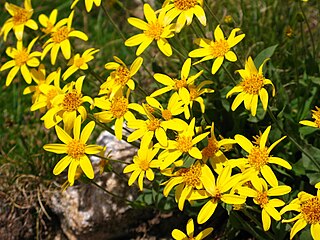
Packera werneriifolia, known by the common names alpine rock butterweed and hoary groundsel, is a species of flowering plant in the aster family. It is native to the western United States in the Sierra Nevada mountain habitat in subalpine and alpine climates, including forests and barren talus.
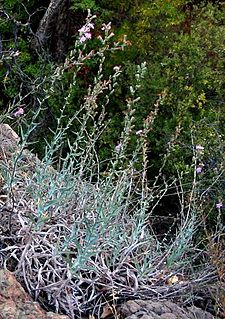
Stephanomeria cichoriacea is a species of flowering plant in the family Asteraceae; it is known by the common names chicoryleaf wirelettuce and silver rock-lettuce. It is endemic to California, where it grows in the coastal mountain ranges as far north as Monterey County, but especially in southern California mountains such as the Transverse Ranges. Its habitat includes chaparral. It is a perennial herb producing slender erect stems reaching maximum heights exceeding one meter. The stem is woolly with hairs, especially on new growth. The leaves are mostly located in a basal rosette, the largest reaching 18 to 20 centimeters long. They are lance-shaped and often toothed along the edges, and the newer ones are woolly. Smaller leaves occur farther up the stem. The inflorescence is a long array of several flower heads, with some occurring in the upper leaf axils as well. Each head has a cylindrical base 1 to 2 centimeters long which is lined with layers of glandular phyllaries. The head contains 10 to 15 ray florets, each with an elongated tube and a pink ligule which may be up to 2 centimeters long. The fruit is an achene tipped with a spreading cluster of long, plumelike pappus bristles.
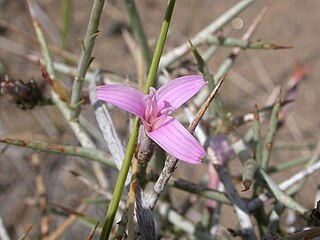
Pleiacanthus is a monotypic genus of flowering plants in the family Asteraceae containing the single species Pleiacanthus spinosus, which is known by the common name thorn skeletonweed, or thorny skeletonweed. It is native to the western United States from Montana and Idaho to southern California and Arizona, where it grows in many types of mostly dry habitat from deserts to mountains. It is a spindly subshrub producing several slender stems up to 40 or 50 centimeters tall from a woody caudex. The stems divide many times into short, rigid branches which narrow to sharp thorn-tips. The plant is mostly hairless except for brownish woolly tufts at the base and below the basal leaves. The leaves are small and linear on the lower stem, and reduced to scale-like growths on the upper branches. Flower heads occur near the ends of the branches. Each has a cylindrical base wrapped in one layer of phyllaries. The head contains 3 to 5 ray florets, each with an elongated tube and a pale to bright pink ligule. The fruit is an achene tipped with a cluster of pappus bristles which are not plumelike as are those of the Stephanomeria species with which this plant was once classified.















